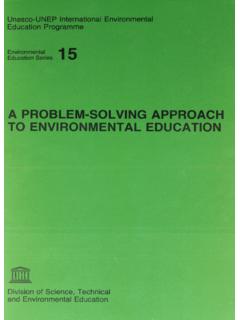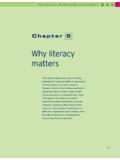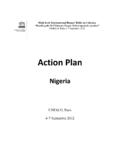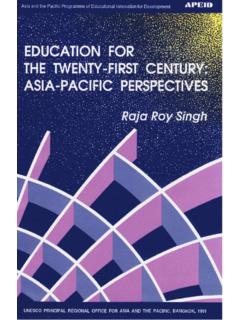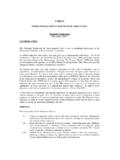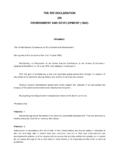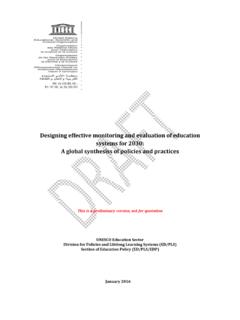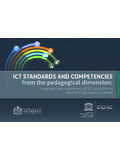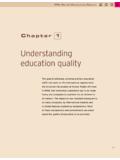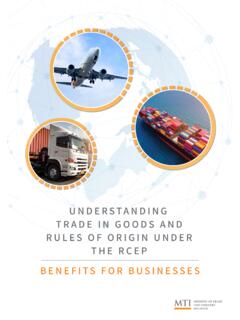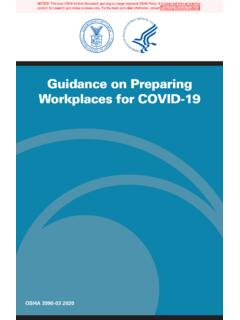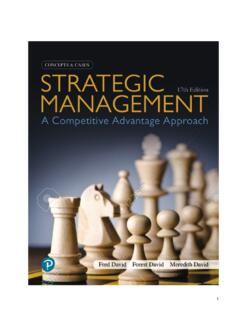Transcription of The Importance of Science, Technology and Innovation ...
1 UNESCO Institute for StatisticsUNESCO Workshop on Surveys on Science, Technology and Innovation (STI) Policy Instruments, Governing Bodies, Policies and IndicatorsHarare, Zimbabwe7-8 November 2012 The Importance of Science, Technology and Innovation Indicators for PolicyMartin Schaaper, UISUNESCO Institute for StatisticsOverviewPart1 Why STI? The need for policies Evidence-based MonitoringPart 2 What are we measuring? The role of the UISUNESCO Institute for StatisticsScience, Technology and Innovation ? (1)The American view:We need to build a future in which our factories and workers are busy manufacturing the high-tech products that will define the Doing that starts with continuing investment in the basic science and engineering research and Technology development from which new products, new businesses, and even new industries are Innovation is more important than ever. It is the key to good paying, private-sector jobs for the American Barack Obama, February 2012 UNESCO Institute for StatisticsScience, Technology and Innovation ?
2 (2)The European view:Our future standard of living depends on our ability to drive Innovation in products, services, business and social processes as well as models. This is why innovationhas been placed at the heart of the Europe 2020 strategy, with the Innovation Union as its Innovation Union is about turning ideas into jobs, green growth and social Institute for StatisticsScience, Technology and Innovation ? (3)OECD Innovation strategy (2007-2010): In 2007, Ministers acknowledged the need for a cross-government policy to harness Innovation as a major driver of productivity that can strengthen economic growth and development. Stronger Innovation , combined with new international partnerships, can also help address pressing global issues such as climate change, health, food security and Institute for StatisticsScience, Technology and Innovation ? (4)China s viewof Innovation as contributing to the green and harmonious developmentof a socialist society: The 17th Party Congress of the CPC specified that Scientific Development, Harmonious Society, and promoting an Ecological Civilization should guide China s social values and Institute for StatisticsScience, Technology and Innovation ?
3 (5)The African Ministerial Council on Science and Technology (AMCOST) stipulates in Africa s Science and Technology Consolidated Plan of Action (CPA) that: The overall goals of the CPA are to enable Africa to harness and apply science, Technology and related innovations to eradicate poverty and achieve sustainable Institute for StatisticsScience, Technology and Innovation policies STI now universally recognised as one of the main drivers of economic growth and societal .. and therefore of poverty reduction as well Governments should aim to harness the benefits of .. and address market failure UNESCO Institute for StatisticsMarket failure Knowledge is discrete and requires large fixed costs (R&D ) price is higher than consumers are willing to pay Uncertainty (moral hazard): research often is unsuccessful Knowledge is a public good Non-exclusive Free riders Positive externalities Result: firms are unable to capture all the benefits to society from their Institute for StatisticsNational STI policy Integrated in the overall national strategic plan Coordinated between the various actors that have a stake ( Ministry of Agriculture, Ministry of Health, Ministry of Higher Education, etc.)
4 UNESCO Institute for StatisticsWhich policy? Innovation policy has developed as an amalgam of science and Technology policy and industrial policy. It takes as a given that knowledge in all its forms plays a crucial role in economic progress, and that Innovation is a complex and systemic phenomenon. Systems approaches to Innovation shift the focus of policy towards an emphasis on the interplay of institutions and the interactive processesat work in the creation of knowledge and in its diffusion and application. The term national Innovation system has been coined to represent this set of institutions and these knowledge flows. (OECD)UNESCO Institute for StatisticsJapan s NISUNESCO Institute for StatisticsEvidence-based policy Tests theory - why will the policy be effective and likely impacts if successful Incorporate some measurement of the impact Examines both direct and indirect effects that occur because of the policy (unintended consequences) Separates the uncertainties and controls for other influences outside of the policy that may have an effect on the outcome Empirical validationUNESCO Institute for StatisticsThe need for data Accountability for spending of public funds requires: Informed strategy and forecasting Indicator-based joined-up policy Coordination of plans and budgets Monitoring Measurement and evaluation of programmes and projects Benchmarking LearningUNESCO Institute for StatisticsIndicators tell a story Do I need to invest in R&D or in Higher Education?
5 In which areas should I invest predominantly? In which areas am I already investing? Which are important economic sectors, in mining, agriculture, industry, services, etc? What are national or regional peculiarities? (health, environment, utilities, defense,..) Do I need to improve quality of higher education or research? Are there sufficient links of universities and institutes to industry?UNESCO Institute for StatisticsSingaporeThe five strategic thrusts for the national R&D agenda intensify national R&D spending to achieve 3% of GDP by identify and invest in strategic areas of R& fund a balance of basic and applied research within strategic provide resources and support to encourage private sector R& strengthen linkages between public and private sector R&DUNESCO Institute for StatisticsKenya Vision 2030 The government will allocate 1% of GDP annually for the R&D sub-sectorand motivate other stakeholders to participate in funding STI.
6 UNESCO Institute for StatisticsTanzania Government funds for R&D are insufficient. Despite the pledge in 2007 to increase R&D funding to 1% of GDP, current funding remains at , according to Dr E. Mbede, Director of Research at the Tanzanian Ministry of Communication, Science and TechnologyUNESCO Institute for StatisticsBotswana The policy will ensure a gradual increase in R&D investment to a target of at least two per cent of the country's GDP (gross domestic product) in four years' time. UNESCO Institute for StatisticsAfrican Union - Nairobi Ministerial Declaration on STI Guided by a commitment reached in 2006 by African Union, ministers resolved that all African countries honour the commitment to devote at least one per cent of gross domestic product (GDP) to R&D and set in place national ST&I policies, by 2015. UNESCO Institute for StatisticsChina China aims to put percent of its GDP into research and development by 2015, says a draft of the country's 12th Five-Year Institute for StatisticsQatar national research strategy Commitment to allocate of GDP to research Quoted in newspapers as a reality, rather than a commitment Data are absent, but anecdotic evidence points in another directionUNESCO Institute for StatisticsA few Africa Kenya Tanzania Botswana China EU SingaporetargetcurrentUNESCO Institute for StatisticsThe EU targetSituation 2000 Eurostat estimateTarget 2010 Target 2001 2002 2003 2004 2005 2006 2007 2008 2009 2010 2011 2012 2013 2014 2015 2016 2017 2018 2019 2020 UNESCO Institute for StatisticsChina s targetSituation 1995 Target 1995 China real dataTarget 2015 UNESCO Institute for StatisticsIntermezzoAny questions?
7 UNESCO Institute for StatisticsAn STI indicators modelInputs (R&D expenditure, Human Resources)Black Box ( Innovation )Output (patents, publications, high-tech products) R&D survey R&D personnel R&D Expenditure Innovation statistics since 2010 Administrative data (patents) Publications databases High-tech data (trade)UNESCO Institute for StatisticsWhat to measure Inputs: R&D Surveys Inputs: Human Resource surveys Education statistics; Higher education statistics; mobility; labour force survey Inputs: infrastructure Intermediate outputs: scientific publications; patents; design; copyright; Outputs: Prototypes; Plant varieties Outcomes: Innovation SurveyUNESCO Institute for StatisticsInnovation Union Scoreboard 2011 UNESCO Institute for StatisticsInnovation Union Scoreboard (EU) 3 main types of indicators 8 Innovation dimensions Human resources Open, excellent and attractive research systems Finance and support Firm investments Enablers Firm activities Outputs Linkages & entrepreneurship Intellectual assets Innovators Economic effectsUNESCO Institute for StatisticsIUS indicators Doctorate graduates, educational attainment and student mobility (Co-)publications, patents, trademarks and designs R&D expenditure Innovation (SMEs) and Innovation expenditure High-growth innovative firms Venture capital Knowledge-intensive services (empl.)
8 And exports) Medium and high-tech product exportsUNESCO Institute for StatisticsMore examplesUNESCO Institute for StatisticsUNESCO Institute for Statistics (UIS) Formerly UNESCO Office of Statistics; Division of Statistics on S&T Established in 1999 September 2001 - the UIS moved from Paris to the University of Montreal, Quebec, Canada 30 November 2001 UNESCO Director-General inaugurates the UNESCO Institute for Statistics in Montreal Director: Mr. Hendrik van der PolUNESCO Institute for StatisticsUIS presence around the world Montreal Nairobi Luanda Bangkok SantiagoApia ParisDakar Windhoek Bamako Yaounde Doha DelhiUNESCO Institute for StatisticsUNESCO Institute for Statistics (UIS) United Nations data repository for: Education Science, Technology and Innovation Culture CommunicationUNESCO Institute for StatisticsUIS is the UN lead agency for STI statistics Official STI data source for UNSD, WB, etc. Data publicly available at: UIS Publications (can be downloaded from the UIS website): S&T Bulletins; Fact sheet, eAtlas on R&D statistics UNESCO ReportsUNESCO Institute for StatisticsAreas of work R&D personnel & expenditure Human resources devoted to S&T and international mobility Innovation data Longer term: Output & ImpactUNESCO Institute for StatisticsLines of action STI survey operations and data guardianship R&D Survey Innovation Survey Training in STI statistics: workshops & other training activities Standard setting and methodological developments Analysis and publicationsUNESCO Institute for Statistics1.
9 STI Survey operation and data guardianship Global survey on statistics of Research and Development (R&D) Biennial, since 2004 Global database on R&D Statistics 2011: Pilot survey of Innovation Statistics 2013: First global data collection of Innovation statisticsUNESCO Institute for Survey on Statistics of Research and Development (R&D) Biennially. 2004, 2006, 2008 and 2010 R&D surveys completed. 5thround was launched in June 2012. Data and metadata released on UIS website ( ). OECD and Eurostat provide data for their Member States. RICYT provides data for Latin America and for a few Caribbean countries. Cooperation with Institute for StatisticsResearch and Development First edition published in 1963! Sixth edition published in 2002 De facto world standardUNESCO Institute for StatisticsR&D: DefinitionResearch and experimental development (R&D)comprise creative work undertaken on a systematicbasis in order to increase the stock of knowledge, including knowledge of man, culture and society, and the use of this stock of knowledge to devise new criterion.
10 Presence of an appreciable element of novelty and the resolution of scientific and/or technological Institute for StatisticsR&D covers 3 activities Basic research (no particular application or use in view) Applied research(directed primarily towards a specific practical aim or objective) Experimental development(directed to producing new materials, products or devices)UNESCO Institute for StatisticsExclusionsExcluded from R&D Education and training Scientific and technological services / Other science and Technology activities Other industrial activities Administration and other supporting activities UNESCO Institute for StatisticsData collection: R&D SurveyR&D Personnel By sector of employment, occupation, qualification, and field of science In headcount and FTE By genderR&D Expenditure By sector of performance and source of funds By type of activity and field of scienceUNESCO Institute for StatisticsUIS 2010 and 2012 Surveys on R&D: response rates & published dataRegions (Countries and Territories covered)Effective responses Q 2010 Effective responses Q 2012 Published data(by June 2012)Sub-Saharan Africa (45)1227%30%37%6%3169%70%Arab States-Africa (9)444%00%667%Asia (31, excl.)
